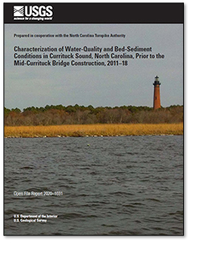Characterization of Water-Quality and Bed-Sediment Conditions in Currituck Sound, North Carolina, Prior to the Mid-Currituck Bridge Construction, 2011–18
Links
- Document: Report (2.42 MB pdf)
- Data Release: USGS data release (html) - Datasets for Characterization of Water-Quality and Bed-Sediment Conditions in Currituck Sound, North Carolina, 2011-18
- Superseded Publications:
- Download citation as: RIS | Dublin Core
Abstract
The North Carolina Turnpike Authority plans to improve transportation in the Currituck Sound area by constructing a two-lane bridge—the Mid-Currituck Bridge—across Currituck Sound from the mainland to the Outer Banks, North Carolina. The results of the final environmental impact statement for the project indicate potential water-quality and habitat effects for Currituck Sound associated with the bridge and roadway improvements.
The primary objective of this study is to characterize water-quality conditions and bed-sediment chemistry in the vicinity of the planned Mid-Currituck Bridge, providing a baseline for evaluating the potential effects of bridge construction and bridge deck runoff on environmental conditions in Currituck Sound. From August 2011 through January 2018, water-quality and bed-sediment samples were collected from five sampling stations along the planned bridge alignment. Samples were analyzed for numerous characteristics, including physical properties and constituents that are associated with bridge deck stormwater runoff and are important to estuarine waters. The analyzed characteristics included dissolved oxygen, pH, specific conductance, turbidity, suspended solids, metals, nutrients, semi-volatile organic compounds, bacteria, chlorophyll a, cyanotoxins, and phytoplankton abundance. The most common constituents with concentrations above applicable State and Federal water-quality thresholds included chlorophyll a, pH, turbidity, Enterococci, and pentachlorophenol. Few bed-sediment samples had constituent concentrations that exceeded applicable sediment-quality guidelines.
Results indicated that water sampled along the planned bridge alignment was well mixed vertically and horizontally but varied temporally. Seasonal changes in water quality best explained the variations in water-quality conditions in Currituck Sound during the study. Wind conditions also influenced water levels and water-quality conditions. Turbidity and concentrations of particle-associated constituents tended to be higher when water levels were lower, possibly reflecting the increased resuspension of bottom materials from wind-driven wave action.
Suggested Citation
Harden, S.L., Fitzgerald, S.A., Wagner, C.R., Bristow, E.L., Loftin, K.A., and Rosen, B.H., 2020, Characterization of water-quality and bed-sediment conditions in Currituck Sound, North Carolina, prior to the Mid-Currituck Bridge construction, 2011–18: U.S. Geological Survey Open-File Report 2020–1031, 67 p., https://doi.org/10.3133/ofr20201031. [Supersedes USGS Open-File Report 2015–1208.]
ISSN: 2331-1258 (online)
Study Area
Table of Contents
- Acknowledgments
- Abstract
- Introduction
- Methods
- Characterization of Water-Quality and Bed-Sediment Conditions in Currituck Sound
- Summary
- References Cited
| Publication type | Report |
|---|---|
| Publication Subtype | USGS Numbered Series |
| Title | Characterization of water-quality and bed-sediment conditions in Currituck Sound, North Carolina, prior to the Mid-Currituck Bridge construction, 2011–18 |
| Series title | Open-File Report |
| Series number | 2020-1031 |
| DOI | 10.3133/ofr20201031 |
| Publication Date | April 15, 2020 |
| Year Published | 2020 |
| Language | English |
| Publisher | U.S. Geological Survey |
| Publisher location | Reston, VA |
| Contributing office(s) | South Atlantic Water Science Center |
| Description | Report: x, 67 p.; Data Release |
| Public Comments | Open-File Report 2020-1031 supersedes Open-File Report 2015-1208 |
| Country | United States |
| State | North Carolina |
| Other Geospatial | Currituck Sound |
| Online Only (Y/N) | Y |
| Additional Online Files (Y/N) | N |


